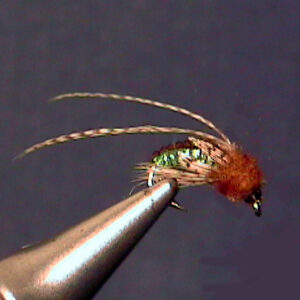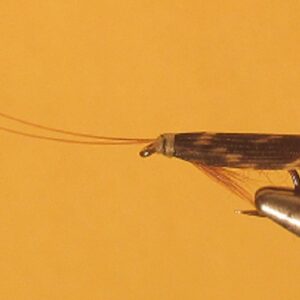Hook Size: 14/16
stage of life of the free- living Green Sedge or Green Caddisfly. The Green Sedge
larva is known to anglers as the Green Rock Worm. It looks and acts like a little
green worm.The Green Rock Worm larvae are available for trout to eat most anytime. They don’t
even build shelters to house themselves on a temporary basis. The larvae move
around on the bottom much like an inchworm does on the ground. They try to get
down in between rocks and gravel to hide but they can’t do that very well. For the
most part they are exposed for the trout to eat most all the time. Like the
net-spinners, they can suspend themselves from rocks with a silk line. They are
poor swimmers but move about on the bottom searching for food much of the time.The Green Sedge larvae look very similar to some of the net-spinning caddisfly
larvae but one simple thing will quickly distinguish the two types of caddisfly larvae.
The Rock Worm is the only one with just one hard plate behind its head.
The rock worms have to have fast, cool water to survive. They have simple,
spike-like gills or either non at all. The Green Sedge larvae (Green Rock worms) live
in riffles, runs and rapids because they must have a steady flow of oxygenated
water that passes over their bodies in order to survive. They prefer broken water of
the riffles and runs.
Presentation:
These caddisflies don’t build shelters to house themselves in. That’s one thing that
makes them different from the net-spinning larvae. The larvae try to get down in
between rocks to hide but they are unable to do that very well. They are poor
swimmers but move about on the bottom searching for food much of the time.
These larvae move around much like an inchworm does on the ground. In fact, if
your caught without any of our Perfect Fly imitations of the larvae, you may get by
fishing the Perfect Fly inch worm imitation.
You should fish imitations of the Green Rock Worm larvae just like you would fish a
nymph in the fast water sections of the streams. You should add plenty of weight to
help keep the fly down on the bottom in the faster current. It’s best to place
split-shot or other types of weight on the tippet about six inches above the fly.
Short, up and across presentations work best in most situations. The high sticking
method of nymphing also works very well for this but any technique that keeps the
fly down on the bottom will work.
You can fish the fly using a strike indicator if you prefer indicators, but because the
bottom of the streams in fast water sections of most trout streams vary greatly in
depth, an indicator hinders your ability to keep the fly on or near the bottom. For
this reason, we prefer to fish the lava imitation without an indicator.


